Books
Books
published in 2024

Itinéraires Fantômes (box set)
Hélène Cixous, Alexandra Grant
Itinéraires Fantômes is an oracle deck created by Alexandra Grant with Hélène Cixous in celebration of H. Cixous' work.
The Itinéraires Fantômes deck consists of 72 cards in six categories: animots, creatures, and entities that include Those from Below, Those from Above, Those Who Fly/Steal, who travel via Portals, manipulate Messages and Symbols, and have Superpowers. The cards are accompanied by a booklet in English and French.
The images on these cards come from family, friends, and artists who have been inspired by Hélène Cixous' writing. Artists include: Adel Abdessemed, Pierre Alechinsky, Sara Barker, Gabrielle Berger, Louise Bourgeois, Leonardo Bravo, Maria Bussmann, Sarah Cain, Lewis Carroll, Bertrand Charneau, Maria Chevska, Michael Kennedy Costa, Laura Darbutaitė, Tacita Dean, Edgar Fabián Frías, Jeffrey Gibson, Francisco Goya, Alexandra Grant, Mathew Hale, Simon Hantaï, Johanna Hedva, Roni Horn, Victor Hugo, Hanna Hur, Franz Kafka, YeRin Kim, Lynn Marie Kirby, Jean-Jacques Lemêtre, Colin Lemoine, Laure Prouvost, Elsa Prudent, Addy Rabinovitch, Keanu Reeves, Cindy Rehm, Saranya Siegel-Berger, Shinique Smith, Nancy Spero, Luc Tuymans, Unyimeabasi Udoh, Roger Viollet, Anna Winger.

Instructions for The Lovers
A taut, tender collection of poems woven with sadness and loss dealing with aging, attachments, and the precarity of life.
“Dawn Lundy Martin’s poems read like a real-time excavation of what poetry can and can’t do,” writes Maggie Nelson. In Instructions for The Lovers, her most stripped down, direct work to date, Martin creates a poetic field dense with thought, image, and sound as she reflects on her relationship with her mother, experiences of queer polyamory, lesbian sex, and the racist conditions within the dying American university system. With rigorously embodied vulnerability and virtuosity, Martin constructs moments of pleasure, humor, and sexiness woven with grief—a tender body to live in.

GLEAN - Issue 4 (ENG edition)
Apparatus 22, Dak’Art, Tarek Atoui, Sirah Foighel Brutmann & Eitan Efrat, Yoko Ono, Pei-Hsuan Wang, Anna Zemánková, Sarah Smolders, Miranda July, Britta Marakatt-Labba, Ignacio Barrios
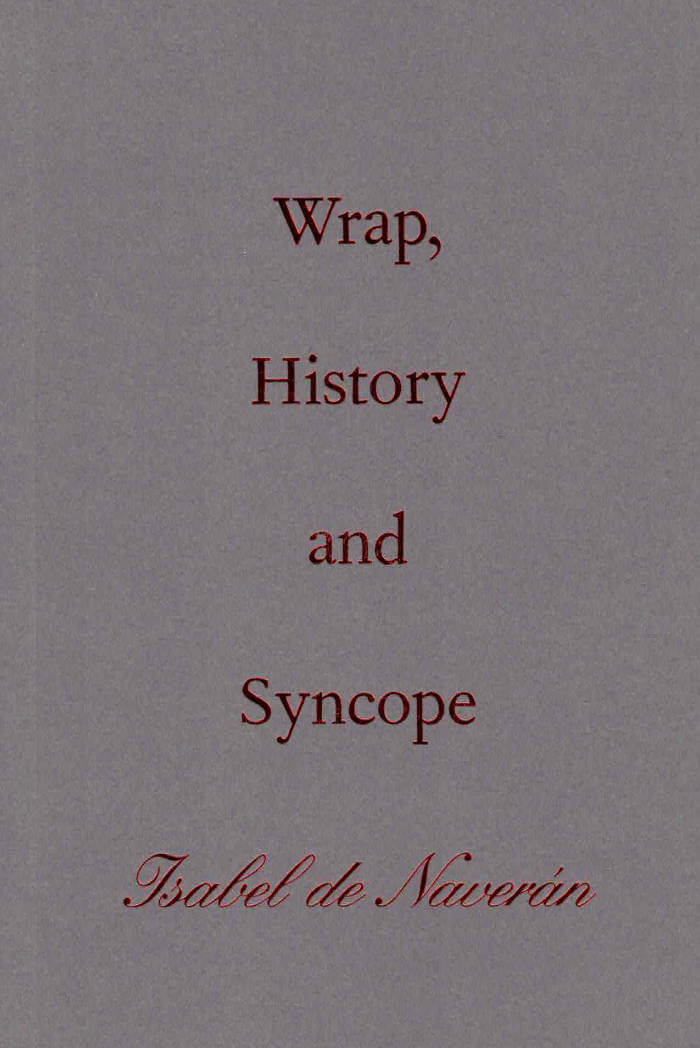
Wrap, History and Syncope
18 July 1936, Bayonne. After hearing the news of the Fascist uprising, the Spanish dancer and bailaora Antonia Mercé y Luque, known as La Argentina, suffers a syncope and dies in fateful synchrony with the Second Republic. History, and the artist’s body, have been seized and broken by the event.
In close dialogue with images and historical documents, Isabel de Naverán pursues the reverberations of that shock and how it resonates with collective pain and artistic translations (by Federico García Lorca, Gertrude Stein, Kazuo Ohno and others). How does history affect and move through bodies? How do living bodies carry and pass on cultural legacy and collective memory? What do these complex movements reveal about the present? Wrap, History and Syncope is an affective journey that invites the reader into tracing and revisiting other bodies, to ultimately dance their difference and multiplicity for oneself.
Isabel de Naverán is a writer and researcher. Concern with the passage and use of time is the backbone of her work, which focuses on bodily transmission and the examination of the concept of historical time by way of ephemeral and fugitive practices. She holds a PhD in art from the University of the Basque Country.
Translation from Spanish: Toni Crabb
Graphic design: Michaël Bussaer
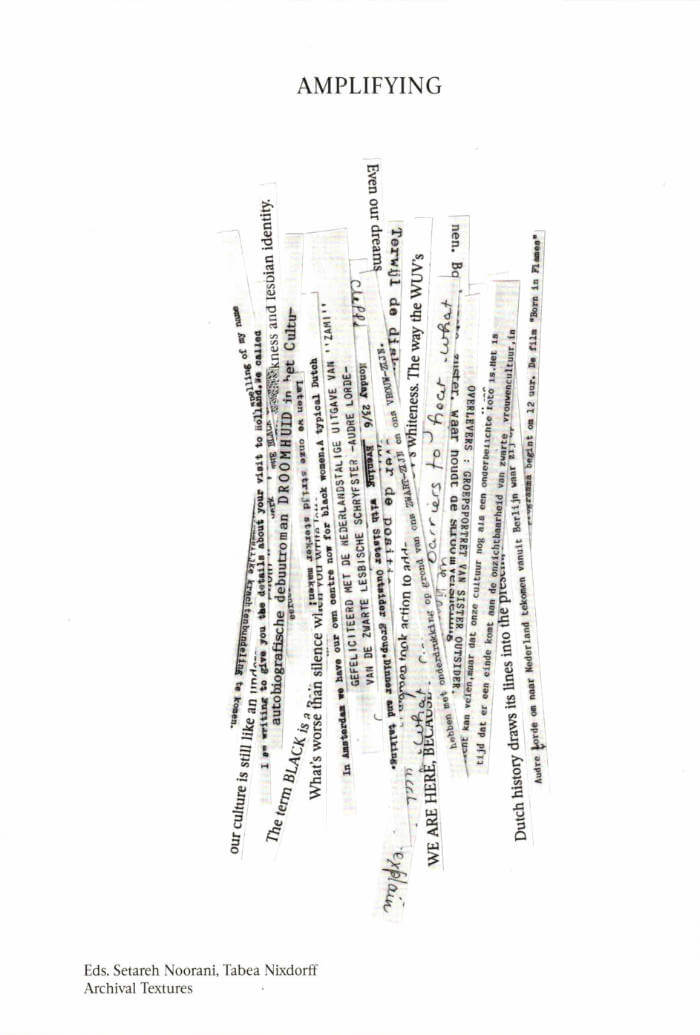
Archival Textures - Amplifying
Setareh Noorani, Tabea Nixdorff
The book Amplifying brings together written manifestations that trace the beginnings of Black feminism in the Netherlands. Amplifying means giving credit to, mentioning, over and over, and supporting the circulation of sources and authors that are formative for our thinking and practices. In the early 1980s, the political term “black” (zwart in Dutch) was introduced in the Netherlands to build alliances between women from different diasporic communities, who were faced with racism in their everyday lives.
Archival materials featured in this book include the original manuscript of the essay “Survivors: Portrait of the Group Sister Outsider” (1984), written by Gloria Wekker in collaboration with the Black lesbian literary group Sister Outsider, the seminal speech Statement of the Black Women’s Group (1983) by Julia da Lima, a contextualizing interview with Tineke E. Jansen and Mo Salomon (1984), excerpts from the book launch of Philomena Essed’s Everyday Racism (1984), and short texts authored by other Black feminist groups in the Netherlands, such as Zwarte Vrouwen & Racisme, Flamboyant, Ashanti, and Groep Zwarte Vrouwen Nijmegen.

Archival Textures - Posting
Carolina Valente Pinto, Tabea Nixdorff
The book Posting brings together a selection of feminist posters from Dutch archives to reflect on posting as an activist strategy, holding the potential to create counter-publics to mainstream culture and to fight against the erasure, exoticization, or tokenism of bodies and experiences that deviate from normative preconceptions.
As is the case for many professions, in the history of Dutch graphic design the absence of women, non-binary, queer, Black designers is striking. This doesn’t only point back to systematic processes of exclusion in the first place, but also to the biases at play regarding whose work is remembered and archived. While efforts have been made to add forgotten names to the existing canon, the many posters, flyers and other printed matter shelved in queer and feminist archives remind us to question the notion of single authorship altogether and instead study graphic design as a decisively collaborative and transdisciplinary practice, which is especially true for community-led and volunteer-based projects.
The posters featured in this book point to this rich landscape of feminist organizing, and were found at the International Institute of Social History and the International Archive for the Women’s Movement (IAV-Atria) in Amsterdam.
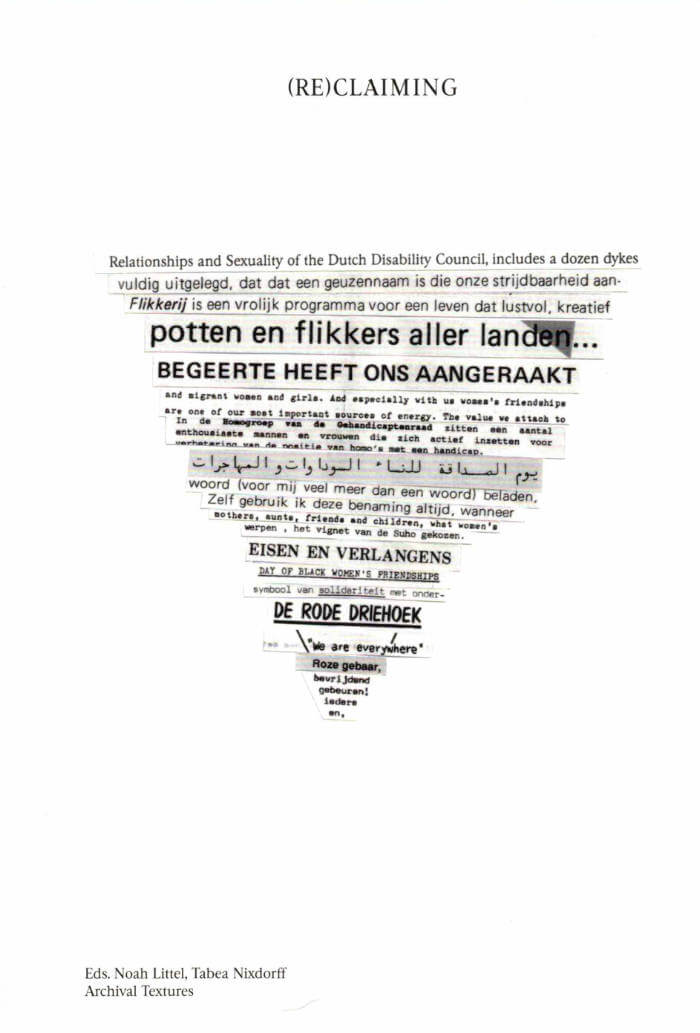
Archival Textures - (Re)claiming
The book (Re)claiming presents ways in which various queer and feminist communities and initiatives in the Netherlands have (re)claimed the triangle—along with other symbols, words and stories—and in doing so take up an empowering position in a hostile society.
Besides a collection of buttons, archival materials featured in this book include short statements and flyers by queer groups such as SUHO, Sjalhomo, Roze Front, Roze Driehoek, Roze Gebaar, Van Doofpot tot Mankepoot, Interpot/ILIS, Lesbisch Archief Amsterdam, Strange Fruit Vrouwen and Groep Zwarte Vrouwen Nijmegen, as well as a text by Karin Daan, the designer of the Homomonument in Amsterdam. With this selection, this book brings together queer, trans, crip, feminist, Jewish and Black perspectives on (re)claiming as an activist strategy.
Most of these materials were researched at IHLIA LGBTI Heritage in Amsterdam, with additions found at the International Institute of Social History and the International Archive for the Women’s Movement (IAV-Atria) in Amsterdam, and LAN Lesbisch Archief Nijmegen.

First Drafts #2: Canonically Speaking
Canonically Speaking is the second title to appear on the First Drafts imprint, a zigzag in Kunstverein Publishing’s output that’s dedicated to publishing completed manuscripts that would otherwise, for an array of reasons, not see the light of day in this rough early form.
Central to Canonically Speaking is the idea that (female) life is an inherently surrealist experience. In this spirit, the ‘absurd’ is embraced as a means to speak out on themes such as self-image, spirituality, mental health and work. While slipping between poetry, comprehensive list-making, knock knock jokes and intertextual references, forms of recital and misinterpretation often take place, whereby characters quote and repeat sentences and words from a large variety of sources, jumping from the health benefits of whale blubber to court transcripts of Bill Clinton's impeachment to the plasma that is released when microwaving two grapes side by side.

The Wastes
After the death of her mother a woman decides to visit a familiar strip of rural upland, darkly identified on the South Pennines Ordnance Survey map as: The Waste. As she moves between trains, shunted by public encounters and haunted by past bar jobs, damp bedsits and a press shot of Vanessa Redgrave smoking in the bath, found slipped between the pages of her mother’s diary, the threshold between her past, present and future self dissolves. Fringe images she has neither designed nor authored begin to steer her toward grid reference 3499, where underfoot the semi-solid mud turns with worms and ants.
The Wastes is published as part of Arrhythmia, a series curated for Book Works by Katrina Palmer.
Roy Claire Potter works between performance and experimental art writing with recent work commissioned by Tate Britain and Tate Publishing, Reduced Listening for BBC Radio 3, Cafe OTO and Counterflows, and Primary. They are Senior Lecturer in Fine Art at Liverpool John Moores University.
Katrina Palmer is an artist and writer, living in London. She is the author of The Dark Object (2010), The Fabricators Tale (2014), End Matter (2015) and Black Slit (2023), all published by Book Works. She has exhibited extensively, including with an Artangel Open commission (2015), at Henry Moore Institute (2015-16), Yorkshire Sculpture Park (2018), and with Estuary and Waterfronts (2021). She received the Paul Hamlyn Foundation Award for Artists (2014).
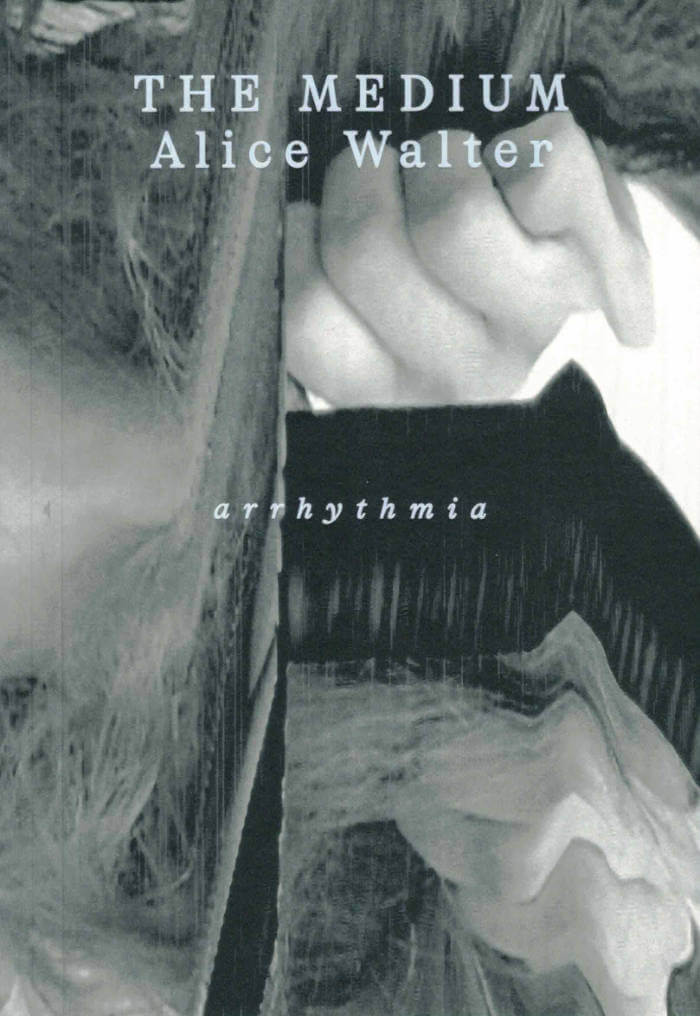
The Medium
To read The Medium is to be submerged in a stream of consciousness populated by uninvited voices from the underworld. Animated, urgent, and brutally propulsive, this cacophony of competing narratives begins to upset the boundary between the living and the dead. The Medium is an alchemical novel, shimmering with insight from the depths of a black lake.
The Medium is published as part of Arrhythmia, a series curated for Book Works by Katrina Palmer.
Alice Walter is an artist, writer and medium – living and working in the UK. She has a BA in Fine Art, Film and Video from Central Saint Martins, UAL and a MFA from The Ruskin School of Art, Oxford University. Her practice combines collage, psychosexual sculpture, VHS and shamanism. Through these disciplines, Alice creates surreal and sensory spaces that open channels for the unseen.
Katrina Palmer is an artist and writer, living in London. She is the author of The Dark Object (2010), The Fabricators Tale (2014), End Matter (2015) and Black Slit (2023), all published by Book Works. She has exhibited extensively, including with an Artangel Open commission (2015), at Henry Moore Institute (2015-16), Yorkshire Sculpture Park (2018), and with Estuary and Waterfronts (2021). She received the Paul Hamlyn Foundation Award for Artists (2014).

Saborami: Expanded facsimile edition
Cecilia Vicuña created Saborami in the aftermath of the September 1973 military coup in Chile. Combining poetry, journal entries, documentation of artworks including assemblages and paintings, the book was published in Devon, England in an edition of 250 hand-made copies by the artist-led Beau Geste Press. It was one of the first artistic responses to the violence of the fascist junta.
In recent years, Vicuña has gained increasing renown, including a retrospective at Kunstinstituut Melly (FKA Witte de With, 2019) and installations at the Guggenheim (2022); and Tate Modern (2023). Saborami is one of her most important works, made at a turning point in her life and career, and reverberating through to the present day. Though the book is highly regarded, it has also been hard to access. This new, expanded facsimile edition remedies this oversight, and restates Saborami as a central example of artistic engagement in material and revolutionary resistance.
Engaging obliquely with the legacies of surrealism, contemporaneous experiments in concrete poetry and the British conceptual art practices of the 1960s and 1970s, Saborami is part of an exilic and internationalist tradition. Years ahead of her time, Vicuña outlines an eco-socialist and feminist vision in the face of defeat.
Coinciding with the fiftieth anniversary of the book’s original publication and of the coup in Chile, this expanded edition contains a new introduction by art historian and curator Amy Tobin and poet and writer Luke Roberts. It includes rarely seen archival material from Vicuña’s time in London, such as contributions to the feminist newspaper Spare Rib, commentary from BBC coverage, and her role in Artists for Democracy in Chile and other solidarity campaigns.

Confidences / Oracle
Oracles don’t require belief—they now theatrically suspend disbelief. No longer advisors of world policy, they run Locus Solus, a town that has come to ramble around an eponymous theatre and chocolate factories. Theo, a centuries-old vampire intent on remaining contemporary through performance, visits Locus Solus, which is hosting Praise Estate, an international theatre festival. He uses the festival as an opportunity to stay with Gean, his oracle boyfriend, who is there visiting family. Theo has a fetish for the future, fixated on the one thing he is in no shortage of.
Confidences / Oracle is a lover’s trip to a weeklong theatre festival. A vehicle for recontextualising recent performance scripts and texts, Oracle is the third instalment in Ivan Cheng’s Confidences series, which intertwines vampires and performance as sites for circulation and recognition.
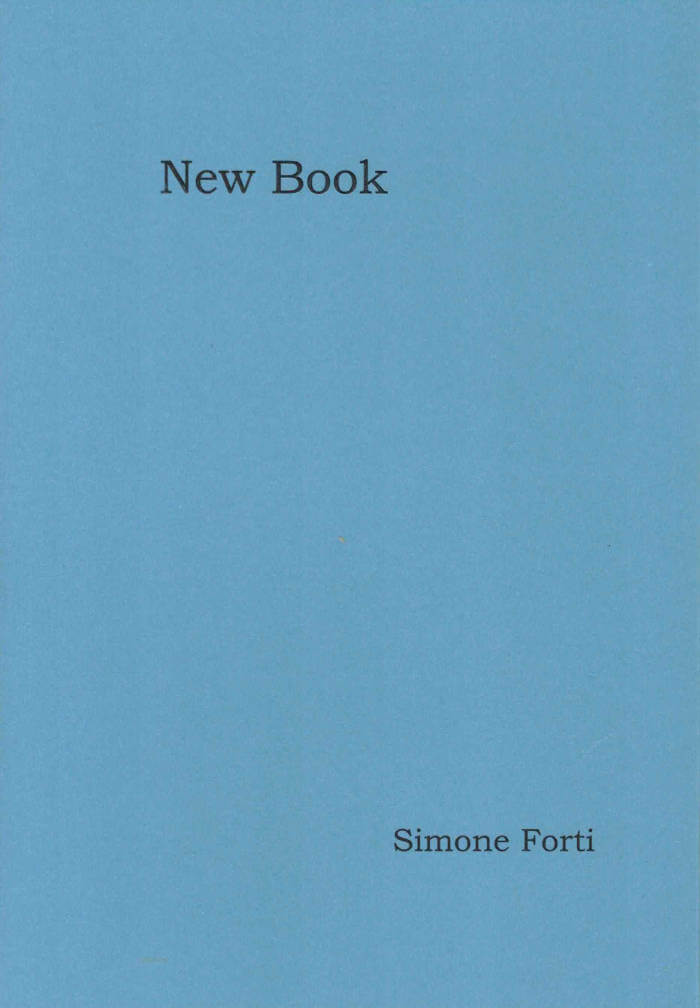
New Book
A new poem composed by the legendary dancer, artist and choreographer Simone Forti.
New Book is the title of a new poem composed of three existing poems re-edited by Simone Forti. As reading this poem, one moves forward with wonder amid everyday memories, recollections of life, a sense of civic duty, glimpses of a precarious world, the beauty of nature, melancholy, a rage to live.
American dancer and choreographer Simone Forti (born 1935 in Florence, Italy) has been a leading figure in the development of contemporary performance over more than fifty years. Artist, choreographer, dancer, writer, Forti has dedicated herself to the research of a kinesthetic awareness, always engaging with experimentation and improvisation. Investigating the relationship between object and body, through animal studies, news animations and land portraits, she reconfigured the concept of performance and dance. Forti emigrated from Italy with her family via Switzerland to Los Angeles in 1938, where she subsequently studied for four years with choreographer Anna Halprin and has since spent most of her life. She joined the experimental downtown art scene in New York during the emergence of performance art, process-based work and Minimal Art and spent a fruitful time in Rome in the late 1960s, where she used the spaces of L'Attico to study and perform. Her work is seen as a precursor of the famous Judson Dance Theater—a group of artists experimenting with dance, including Trisha Brown, Steve Paxton, and Yvonne Rainer—and Minimal Art, although she prefers to be referred simply as a "movement artist."

What Can Theatre Do
Miguel A. Melgares, Silvia Bottiroli
What Can Theatre Do invites artists and thinkers to explore the potential of the performing arts, the political role of theatre and its ability to imagine alternative realities and future scenarios, ranging from essays to artistic interventions.
At a time when the relation between art and society is under permanent scrutiny, the utterance What can theatre do serves as an open invitation for artists and thinkers alike to reimagine the potential agency of the performing arts. The formulation of this sentence is both ambitious and ambiguous since the affirmative or interrogatory status remains undefined. The intonation of the sentence can provide both a sense of hope and belonging or a nihilist sensation of powerlessness. It could provide a resource for research development and analytic inquiries, but could also serve as a suggestion to trigger political action.
From fictional interviews to recipes, social-media exchanges to dramaturgical texts, theoretical essays to artistic interventions, the contributions gathered here are a diverse and multifaceted collection of dialogues. These interventions are singular and unique but share concerns and desires about the politicality of theatre as a realm where possible alternative realities can be enacted and potential future scenarios can be collectively rehearsed.
What Can Theatre Do tries to explore the idea of a book as a complex performative apparatus that can generate a space within which art and theory, and therefore also strategies of reality-making and of fiction-making, can entangle and affect one another, creating possibilities for the emergence of the not yet imagined.
Contributions by Lotte van den Berg, Carolina Bianchi, Silvia Bottiroli, Ilenia Caleo, Laura Cull Ó Maoilearca, Piersandra Di Matteo, Valeria Graziano, Ainhoa Hernández Escudero, Samara Hersch, Asa Horvitz, Mala Kline, Low Kee Hong, Tom Oliver Jacobson, Miguel A. Melgares, Juan Miranda, Ogutu Muraya, Mazlum Nergiz, Andrej Nosov, nyamnyam (Ariadna Rodríguez and Iñaki Alvarez), Giulia Palladini, Venuri Perera, Livia Andrea Piazza, Amanda Piña, Annalisa Sacchi, Mariana Senne, Agat Sharma, Lara Staal, Elioa Steffen, Rolando Vázquez, Elioa Steffen, Suvani Suri, Pankaj Tiwari, Ingrid Vranken.

desespiegles
This publication is presented as an object-book-manifesto of a ‘desespiegles’ way of thinking. It “translates” the trains of thought that architect-artists Anne Philippe and Jolien Naeyaert exchanged via videoletters. The videoletters mainly occurred during the covid period. Questioning the scope of the addressed images, these exchanges revealed a play of symmetries. It shows a series of interrogations, linking the intimate with the collective. The move towards a publication was obvious after conversations with Loes, Phyllis, An and Teresa of nadine. The desire to activate reading in a performative way, mirrors the exchange of videoletters. It continues the process-based methodology that inventively gave birth to a publication through the physical manipulation of the work. The riso-technique proved particularly suitable for this project, as the hands, the gaze and the exchange all played a role during the object-making process.
Dannie.n is an art-zine, published by nadine, about the artistic research, themes, and topics of discussion of the artists involved in nadine. nadine invites an artist or collective to create each new edition.
Dannie.p is a limited-edition artist's book by desespiegles (57 copies). nadine is supported by Vlaamse Gemeenschap, VGC, Brussels Hoofdstedelijk Gewest.

sur la route
sabiche, les lutins dîle de france and 1 more
Sur la route, de sabiche est la version housewife-poétesse kicked out de la maison où elle vivait, qui se retrouve on the road yeah, le long des pissenlits traînant d'énormes valises, pleines de livres et de bidules inutiles-essentiels, dont un crâne humain avec qui elle parle. Des lutins et Dodie Bellamy - dont sabiche traduit l'essai "L'écriture comme accumulation compulsive" - viennent l'aider...

écrissa bolossa
Frustration, inflammation, licences commerciales, torture et choux qui accouchent. Ça commence mal à Montreuil. Et ça finit dans le Kentucky. Là où tout a vraiment commencé.


Experimental Translation
The history and future of an alternative, oppositional translation practice.
The threat of machine translation has given way to an alternative, experimental practice of translation that reflects upon and hijacks traditional paradigms. In much the same way that photography initiated a break in artistic practices with the threat of an absolute fidelity to the real, machine translation has paradoxically liberated human translators to err, to diverge, to tamper with the original, blurring creation and imitation with cyborg collage and appropriation.
Seven chapters reimagine seven classic “procedures” of translation theory and pedagogy: borrowing, calque, literal translation, transposition, modulation, equivalence, and adaptation, updating them for the material political and poetic concerns of the contemporary era. Each chapter combines reflections from translation studies and experimental literature with practical guides, sets of experimental translation “procedures” to try at home or abroad, in the classroom, the laboratory, the garden, the dance hall, the city, the kitchen, the library, the shopping center, the supermarket, the train, the bus, the airplane, the post office, on the radio, on your phone, on your computer, and on the internet.

The Ginny Suite
A mysterious global syndrome is affecting women, causing symptoms of submissiveness and aphasia. While the number of sufferers grows, so does our protagonist’s paranoia—of the media, her doctors, and her husband. In the age of misinformation, AI, and surveillance technology, The Ginny Suite asks how much—and who—we’re willing to sacrifice in the name of progress.
The Ginny Suite is formally innovative, a great read. Stacy Skolnik recasts the subject of the internet into telling particulars in her affecting choreography of memes/screens/women/men. — Constance DeJong, author of Modern Love
The Ginny Suite is a perfect hell of a book: a gossipy stylish mystery that’s both petty and profound. I love how its paranoias and insecurities tip lushly into plot: is the lyric condition of poetry a pathology? Is dissociation a radical response to the lived conditions of patriarchy, or is it patriarchy hacking your brain into submission? What if, instead of self-diagnosing through google, your search history was used to diagnose you, and form the basis of covert treatment? Anyone who’s ever suffered the malady of writing poems will recognise The Ginny Suite’s inability to stop picking these scabs. Its prose moves seamlessly from the lush to the blunt, awash with glitching pronouns, horny ennui, sci-fi intrigue and tender girlish digital fantasies—like if the author of Malina had a dormant Neopets account. I adored it. — Daisy Lafarge, author of Lovebug
Perversely brilliant, fearlessly inventive, The Ginny Suite beautifully illustrates the horror of being a thinking person inside of a body and culture rushing toward the graveyard. — Brad Phillips, author of Essays and Fictions
The Ginny Suite proves that Stacy Skolnik is one of the most timely and original voices in post-pandemic New York. — Joshua Citarella, author of Politigram and the Post-left
A Handmaid’s Tale for the Post-Truth-AI-Surveillance Era. — Suzanne Treister, author of Hexen 2.0
Stacy Skolnik is the author of the poetry collection mrsblueeyes123.com (self-released, 2019), the chapbook Sparrows (Belladonna* Collaborative, 2023), the workbook From the Punitive to the Ludic: Prompts for Writing Public Apologies (with Thomas Laprade for Montez Press Radio, KAJE, 2022), and the chapbook Rat Park (with Katie Della-Valle, Montez Press, 2018). She is a co-founder and co-director of Montez Press Radio, the Lower East Side-based broadcast and performance platform. The Ginny Suite is her debut novel.

Basta Now. Women, Trans & Non-binary in Experimental Music
Basta Now. Women, Trans & Non-binary in Experimental Music is a non-academic essay by French poet, novelist and music enthusiast Fanny Chiarello. It’s also the first book to be published by Permanent Draft, an all-female record label and micro-press founded by Chiarello & musician Valentina Magaletti, dedicated to promoting contemporary female, non-binary and transgender artists.
Basta Now is essentially a huge (yet admittedly not definitive) overview of 2,371 womxn in the global experimental sound & music scene. It’s been writ ten in playful and compelling prose and stylishly presented with photos, illustrations, and discographies.
“This book has nothing against men, it’s just not about them” (Fanny Chiarello)

New Address II. Stereotypical Artist
What is an artists’ life made of? From the home to the studio, from the studio to the gallery, from one exhibition to the next, from one place to another – a suite of moves and a list of addresses. Tobias Kaspar’s work sheds light on the ambivalent position of the artist, taken in a web of social and economic relations: in the second volume of New Address, he uses the tone of the diary, combined with the code of the moodboard, to document the side aspects of the life of a “stereotypical artist.”
The book gathers black & white photographs taken between 2018 and 2024, during the installation or the opening of exhibitions; at performances, dinners, parties; in different homes and rooms Kaspar has been living in; and in the course of daily activities. Contrary to an exhibition catalogue, projects by the artist such as his line of jeans, or his series of bronze sculptures made from disposable packaging, are thus shown “in the middle of affairs.”
An additional booklet opens with a short essay by artist Mikael Brkic, reflecting on the “behind the scenes” logics, followed by a letter penned by writer Leif Randt, and a text in which curator Kari Rittenbach discusses Tobias Kaspar’s work in relation to the economics and aesthetics of display and fashion. It concludes with a list of artworks in the order as they appear in the main book.
Published with the support of Erna und Curt Burgauer Stiftung, Pro Helvetia, Kultur Stadt Zürich.

Candles and Water
Candles and Water is a queer pillow book: a document of wreckage, haunting, and survival.
This collection is made of fictions and diaries, dreams and lists, lies and ghost stories. Its fragments and filaments are lonely, joyous, enraged, sickly, and lost; and when they crystallize around a single voice, it is by way of healing from grief and recovery from addiction.
Timothy Thornton is a writer and musician. His work was in Volume 2 of the new Penguin Modern Poets series, and he has published eleven books of poetry with small presses. He organised two series of reading and performance nights in Brighton: 'evenly and perversely' and 'WHAT YOU NEED'. He has composed and performed scores for productions at Battersea Arts Centre and The Yard Theatre.
'Candles and Water risks everything, daring to explore powerful vulnerabilities, yearning, and unabashed hope. Elusiveness and the whisperings of shadows inhabit these pages, always illuminated and burnished by the voice of a poet'. — Thomas Glave, author of Among The Bloodpeople
'Timothy Thornton's Candles and Water is a rare and transformational book, haunting, beautiful and watchful. Writing that follows its brush like Sei Shōnagon.' — David Hayden, author of Darker with the Lights On
'These radical, scattered shards of life and sensation. . . come to a whole, coalescing like bioluminescence. . . witty, dark, profound, devastating. One long séance with a fellow human soul.' — Philip Hoare, author of RISINGTIDEFALLINGSTAR
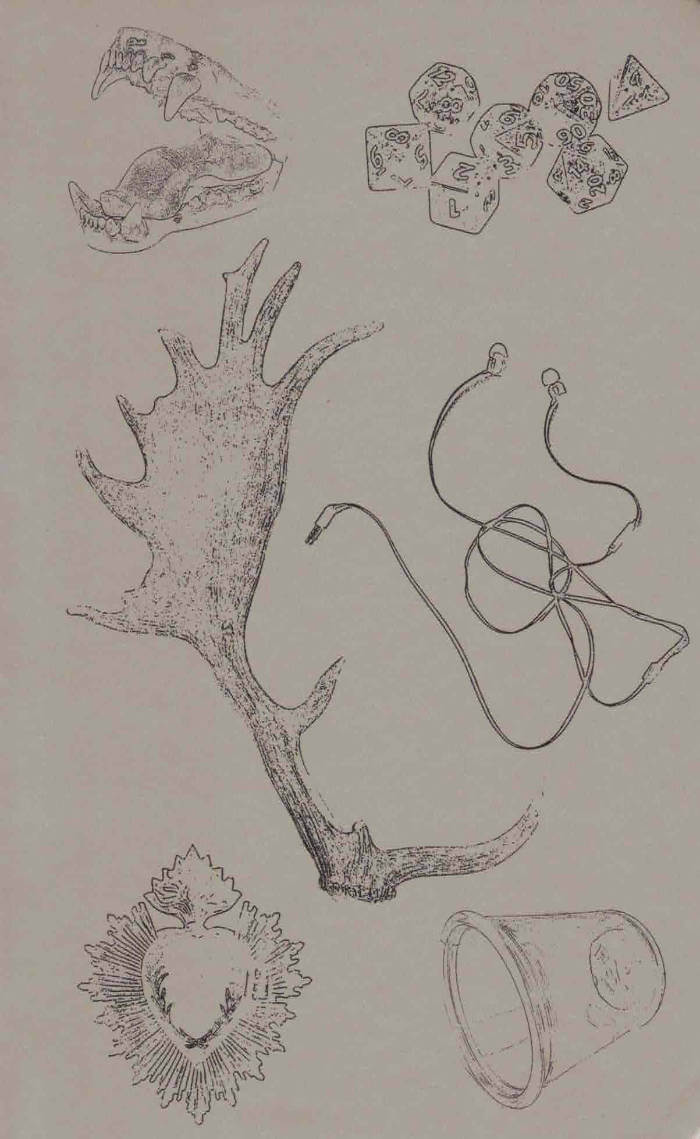
to enter the forest
to enter the forest is an invitation to suspend the acquired systems of knowledge, to look for other ways of “world making.” The book includes a revised and extended version of to err together with the unpublished correspondances.
to err gathers walking exercises and notes, created as instruments for choreographic composition, but practicable by anyone, to put one’s perspective about self and what is other to self, as well as the relations between things, even beyond the human, into question.
correspondances is an ensemble of writing exercises through which to investigate the system of consciousness around verbal language, asking ourselves what words mean from a slightly shifted perspective.
The publication is coproduced by a.pass, nadine, Buda Art Centre, Indisciplinarte, Flanders State of the Art.
lucia palladino is a transdisciplinary artist and researcher in the fields of performance, choreography, and dance. Her practices consist in the elaboration of forms of resistance to notions of identity and ownership naturalized by history and by culture, that define our knowledge and expectations and that need to be undone in order to make space for meeting.